|

by Philip Coppens
This article originally appeared in
Frontier Magazine 10.5
(October/November 2004)
from
PhilipCoppens Website
|
Macchu
Picchu, Nazca, Tiahuanaco… Though the major monuments of
Peru are mapped and known – though the jungle continues
to surrender some of its secrets even today – so far
these spell-binding monuments have largely been looked
upon in isolation, without trying to interlock the
various monuments with each other – let alone possible
interoperability. |
For many years, the monuments of Egypt were often interpreted within
a narrow context. To some extent, the possibility of links between
Egypt and Sumer/Babylonia, though geographically close, is still
frowned upon as “unwise” to venture into. The same previously
applied to the megalithic monuments of Western Europe. However, in
recent decades, major inroads have been made to understand those
stone monuments within their landscape, and that global picture
within the framework
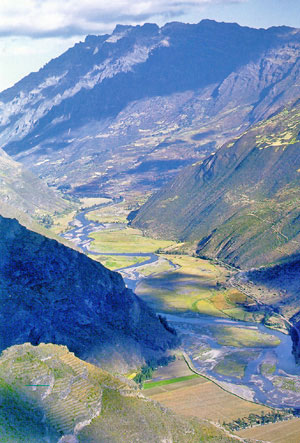 of
the myths – often creation myths – of the people or their ancestors
who built those monuments. of
the myths – often creation myths – of the people or their ancestors
who built those monuments.
However, Peru was largely left outside of
the framework and thus was only quoted by the likes of Erich von Däniken or
Graham Hancock, who included the monuments of Peru as
examples of ancient high engineering precision. However, such
isolated attention also meant that the monuments were not explained,
and thus understanding did not occur.
In recent years, several archaeologists and other researchers have
focused their attention on Peru, in an effort to interpret its
monuments within its proper context. The official history of the
Incas is extremely sad: most were wiped out by a relatively small
Spanish army who were uninterested in mapping their civilization.
Though the gold of the Egyptian past has often been removed from
Egypt, at least it has been largely preserved; the fate of the Inca
gold was that it was melted, before being shipped to Spain, where it
was intercepted by English pirates… Though the Inca civilization is
merely several hundreds years old, we are thus faced with an equal
problem to that of the ancient Egyptian civilization: that it is
impossible to interrogate directly or have a large database at our
disposal to learn about this culture.
The Spanish called the Inca culture “diabolical” and until recently,
it was deemed to be “primitive”. The Western mind was incapable of
understanding why a civilization would practice human sacrifice. The
Inca civilization was often not included in school curriculum in
Western Europe.
Over the past forty years, that veil of ignorance is
slowly being lifted, specifically because of the enormous interest
created by Erich von Däniken et al. Though his suggestions as
to what the Inca monuments might be, it is a fact that his
“outlandish” suggestions generated an interest in the monuments and
offered scientists the possibility (if not funding) to analyze the
monuments in greater detail. Performing the function of a catalyst
is no mean feat…
Von Däniken posed the central question as it stood in the 1960s: if
the Inca were primitive or stupid, how had they been able to create
their often complex buildings, such as Sacsayhuaman or Ollantaytambo.
If indeed stupid, who aided them? If no-one can be identified, do we
need to look towards extraterrestrial beings?
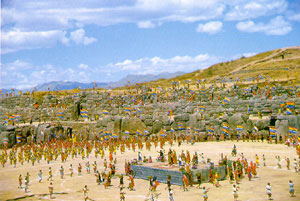 Since
then, the questions are still posed, but the circumstances are
vastly different then they were. It is now clear that the Inca were
not stupid. It is furthermore clear that the Inca built upon
centuries of knowledge available to their predecessors, present
across the continent they united. They were the last indigenous
group of rulers who had toiled the land for hundreds of generations,
if not thousands of years. Since
then, the questions are still posed, but the circumstances are
vastly different then they were. It is now clear that the Inca were
not stupid. It is furthermore clear that the Inca built upon
centuries of knowledge available to their predecessors, present
across the continent they united. They were the last indigenous
group of rulers who had toiled the land for hundreds of generations,
if not thousands of years.
Nevertheless, the question of “what” their civilization represented
is still largely unanswered. The main part of answering this
question has been carried by Peruvian archaeologists, as well as a
certain amount of visiting scientists. This has resulted in a
radically new approach and interpretation towards what the backbone
of the Inca culture was about.
Two key people in this quest are Fernando and Edgar Elorrieta
Salazar. The main interest of the Inca civilization is the
“Sacred Valley”, which stretches from Cusco, the “navel” of the Inca
world to
Machu Picchu, the best known Inca structure that was
rediscovered by Hiram Bingham in 1911. Practically, the valley
continues south of Cusco, towards Lake Titicaca. Situated at an
altitude of 4 kilometers, the lake is the highest navigable lake in
the world. It was on an island in this lake, the Island of the Sun,
that the Inca legends state that the creator god, Viracocha,
appeared on Earth. It is from here that Viracocha’s voyage began.
Amidst spectacular scenario, the valley descends to 3400 meters in
Cusco and 2800 meters in Machu Picchu. Though the rivers will
contribute to the Amazon river, it is said that Viracocha continued
on his path, walking SE/NW, until he reached the Pacific Ocean.
The legend of Viracocha and how he “walked” the sacred valley brings
us face to face with the enigmas of the Incan civilization:
Tiahuanaco, Cusco en Sacsayhuaman, Ollantaytambo and Machu Picchu.
Several books about each topic have appeared, but few books have
tried to interpret the various sites as a whole. This latter
approach is important, as rather than a segmented view of the Inca
civilization, it would present a global view of the exploits of
Viracocha – a view that would be based on Inca mythology, and not
just scientific analysis of the individual site.
The building work of the centers in the Sacred Valley is thus a
transformation in stone of the “Holy Road” travelled by the Creator
Deity. The recent importance of Machu Picchu has inverted the
importance of this “path”. The Salazar brothers clearly identify
that Ollantaytambo was much more important. Though at first
apparently much less impressive than Machu Picchu, its sitting
within the landscape is nevertheless complex – and contains more
symbolic detail than eg Machu Picchu.
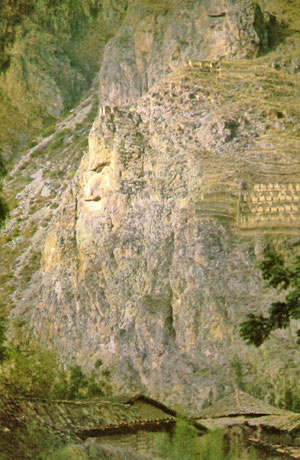 Research
has identified that the Inca civilization had specific preferences
of alignments to mountain tops, evidence of which can be found in
Machu Picchu. At Ollantaytambo, similar evidence can be identified,
but the detail is more specific. Research
has identified that the Inca civilization had specific preferences
of alignments to mountain tops, evidence of which can be found in
Machu Picchu. At Ollantaytambo, similar evidence can be identified,
but the detail is more specific.
Both sites are orientated towards a
mountain, but at Ollantaytambo, the profile of a human being,
identified with Viracocha, can clearly be distinguished. The Salazar
brothers have furthermore identified that the temple at
Ollantaytambo is aligned to certain notches in that hill, the
alignment of which is with important sunrise events in the calendar.
The stone face of Viracocha (image
right) towering over Ollantaytambo is part of
the Inca legend; his presence shows that the creator god was still
present, “looking”, “watching over” his people. There are more such
alignments: the Salazar brothers identified that in the valley below
Ollantaytambo, the first beam of the sunrise falls on the so-called
Pacaritanpu, the House of Dawn, where the gods became “God”.
This
structure is hardly identifiable, unless it is looked upon with the
“right eyes”. At first, there appears to be nothing but a cultivated
field. Though dating from the Inca time period, it is hardly
recognizable as important. But a second glance will reveal that the
entire field portrays a gigantic pyramid; the position where the
sunbeam hits the ground has been clearly and uniquely marked by a
structure.
Such subliminal images in the Inca structures are not unique.
Elsewhere, the Inca’s have incorporated the same technique, often in
city planning. The Salazar brothers have identified various animal
forms in the hills and designs of Machu Picchu, depending on the
point of view from where the monument is observed.
The design of the
capital Cusco is equally ingeniously created to form the image of a
puma, the “royal animal”. Many of these constructions were a mixture
of natural shapes, augmented – “stressed” – by human intervention,
often by creating fields.
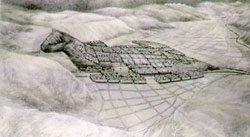
The notion that sacred geography
underlines Inca city planning is not a new observation. The Jesuit
Father Bernabe Cobo, in his book The History of the New World
(1653), wrote about ceques in Cusco. These were lines on which
wak’as – shrines – were placed and which were venerated by local
people. Ceques had been described as sacred pathways.
Cobo described how ceques radiated outwards from the Temple of the
Sun at the centre of the old Inca capital. These were invisible
lines, being only apparent in the alignments of the wak’as. The
ceques radiated out between two lines at right angles, which divided
the city into four and extended out into the Inca Empire.
Each ceque
was in the care of a family. Wak’as mostly took the form of stones,
springs, hills, or stones on hills. Offerings were made, often in
the form of human sacrifice, usually of small children. These
ceremonies began in Cusco and culminated in a sacrifice at specially
designated sites often located near the summits of holy mountains.
|
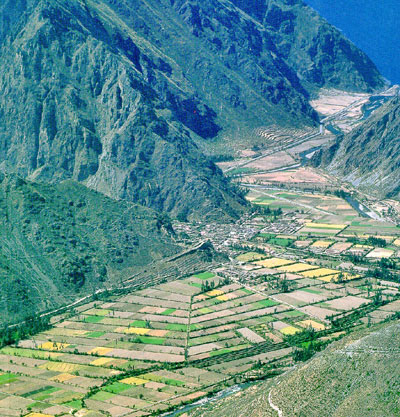 |
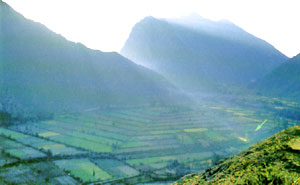
The Pyramid
of Dawn (left) which is difficult to discern,
unless one makes a careful analysis of the
organization of the fields, which form the shape of a
pyramid.
One of the
rectangular fields on the right hand side of the pyramid
is the location where the first beam of sunlight on June
21 falls (see above), proving that the entire
structure is a complex engineering feature that
expresses the Inca creation legends. |
Beyond the “Sacred Path” is an even deeper message. Modern research
suggests that the Sacred Valley of the Vilcamayu and Urubamba rivers
symbolized the Milky Way. Identifying rivers with constellations,
specifically the Milky Way, is nothing new. Other examples are the
Nile, as well as the Po in Italy and the Rhône in France.
John Major Jenkins is one of several researchers – and a growing
number at that – who have analyzed the astronomical components of
the Central and Southern American cultures. Jenkins argue that
archaeologists need to do more than merely make high level
statements such as the notion that the Inca civilization practiced
solar worship. Why did they have a sun cult? What religious message
was introduced within this notion?
Jenkins believes that the answer can be found in the belief that the
Galactic Centre, the centre of the Milky Way, is the origin, or
goal, of the soul’s travel, a type of star gate into another
dimension – God. This knowledge was incorporated into the calendar
of the Maya. The same knowledge was depicted on the landscape of
Peru.
Cusco, the capital, the “navel of the world”, is situated between
two rivers. This corresponds with the dark “gate” north of
Sagittarius, the “gate” to this other dimension. But more intriguing
is that within this interpretation, Lake Titicaca is the location of
the Galactic Centre. There is therefore a consistency between what
Jenkins has identified as the core belief of the Maya and the
geographical mapping of the Inca civilization.
These radical interpretations that are being put forward will no
doubt require time before they will be accepted by each and all.
Still, they sit within a worldwide phenomenon, of creator beings
walking the land, sculpting it as they go, turning into rocks, etc.
The phenomenon is well-known with the
Aboriginals and their Songlines in Australia.
It will take even longer before their influence and novel approach
is adapted and adopted by archaeologists and researchers trying to
identify other ancient or enigmatic civilizations. Meanwhile,
several tourists continue to walk the Sacred Path of Viracocha: many
travel from Tiahuanaco, to Cusco, onward to Ollantaytambo and
finally Machu Picchu. The path is a natural way of moving about the
country and has been walked for hundreds of generations, from the
earliest farmers to the Inca kings… It is an opportunity for every
man to walk in the footsteps of Viracocha – God.
|

 of
the myths – often creation myths – of the people or their ancestors
who built those monuments.
of
the myths – often creation myths – of the people or their ancestors
who built those monuments.  Since
then, the questions are still posed, but the circumstances are
vastly different then they were. It is now clear that the Inca were
not stupid. It is furthermore clear that the Inca built upon
centuries of knowledge available to their predecessors, present
across the continent they united. They were the last indigenous
group of rulers who had toiled the land for hundreds of generations,
if not thousands of years.
Since
then, the questions are still posed, but the circumstances are
vastly different then they were. It is now clear that the Inca were
not stupid. It is furthermore clear that the Inca built upon
centuries of knowledge available to their predecessors, present
across the continent they united. They were the last indigenous
group of rulers who had toiled the land for hundreds of generations,
if not thousands of years.  Research
has identified that the Inca civilization had specific preferences
of alignments to mountain tops, evidence of which can be found in
Machu Picchu. At Ollantaytambo, similar evidence can be identified,
but the detail is more specific.
Research
has identified that the Inca civilization had specific preferences
of alignments to mountain tops, evidence of which can be found in
Machu Picchu. At Ollantaytambo, similar evidence can be identified,
but the detail is more specific.


